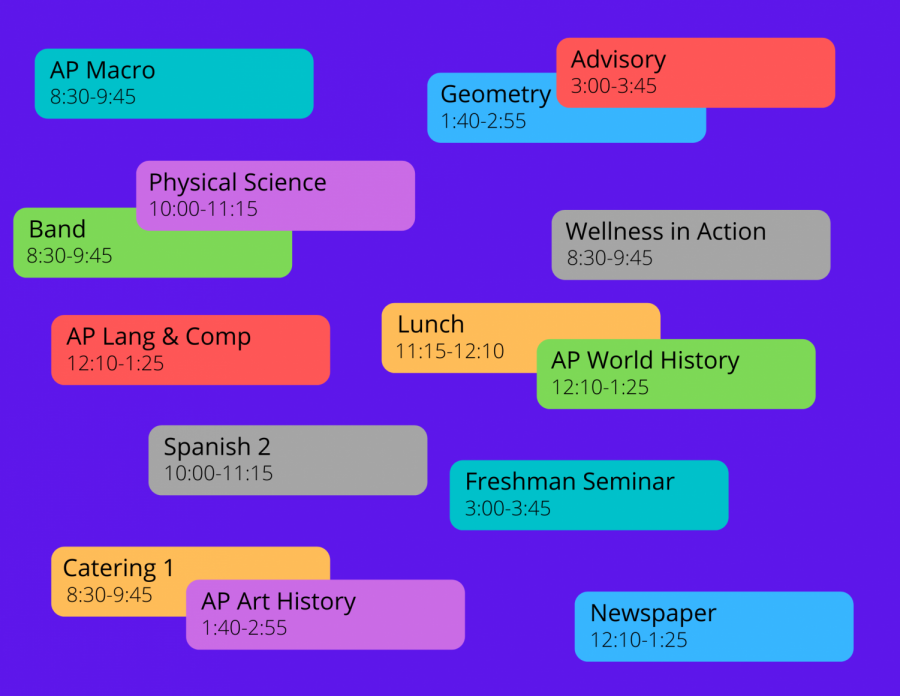Boulder High’s New Schedule
Is it a step in the right direction?
The days are packed, but Boulder High’s new schedule makes everything easier to manage.
In 2018, an educational earthquake shook Boulder High to its core in the form of a switch from a seven-period class schedule to an eight-period one. It took a few weeks for students to get their heads around the change, but once the school adapted to the new schedule, the prevailing opinion was that the switch was a good one.
Now another schedule shake-up has hit Boulder High—one that was adaptive instead of preplanned, but one that has the potential to be just as good. I’m talking about the simultaneous switch to online learning, the quarter system, asynchronous learning on Mondays and an overall reduction in-class time. The COVID-19 schedule was deemed a better fit for online learning and cohorts to return to in-person school, but the new schedule has also steered Boulder High onto a path that can lead to educational excellence; as well as increasing students’ wellbeing, we have unwittingly copied one of the world’s preeminent school systems.
To be clear, this article advocates for Boulder High’s current schedule as it could function in a “normal” learning environment. While I understand its current necessity, online school has presented many challenges to students and is not something I would endorse outside of the present situation. The Owl has previously published articles that commend the quarter system. Still, the addition of asynchronous learning on Mondays and reduced class time results in great potential to improve the standard of education at Boulder High.
Asynchronous learning has perhaps had the greatest effect on students’ well-being of all the scheduling changes brought on by 2020. As a clarification, asynchronous learning does not mean “you now have a three day weekend, go do whatever you want.” Rather, Monday is a day where there is work to be done, but it can be completed on one’s own schedule, allowing for greater flexibility and a more gentle re-entry into the school week. Some students procrastinate this work all day before completing it in a late-night frenzy, but for me, Mondays are my most productive days. Because I’m not required to be on a Google Meet at specific times, I have the freedom to jump between tasks—completing my schoolwork, tackling college applications and spending time outside. As well as being an exercise in time management, Mondays are my warm-up for the week, so by Tuesday, I’m ready to jump back into all-day school.
Boulder High’s new schedule has also resulted in reduced class time. Instruction time for year-long classes has been reduced by about 50 hours, though students make up some of that time on Mondays. While the abbreviated course lengths and sometimes-frantic pace of classes are lamentable, the new schedule forces teachers and students to be efficient with their time. Before, the plentiful class time allowed for sometimes-irrelevant digressions that distracted everyone from actual learning. Now that the new schedule leaves us pressed for time, teachers have to quickly get to the point and emphasize the most important take-aways of their lessons.
Junior Chloe Fraser said that despite the time crunch, she feels that she’s still receiving a quality education, noting that her teachers have to be more concise during class and focus on their course aspects that will best serve their students’ lives and academic careers. Students’ grades don’t seem to be suffering from the shortened school week—as of Oct. 6, 57 percent of students in Mr. O’Block’s advanced physics classes had an A—although this could be due in part to teachers condensing their curriculums, thus giving students less content to digest.
No change comes without an adjustment period, but once mastered, this pared-down schedule has the potential to emphasize independent, focused learning without sacrificing long-term academic success. Compared to other countries’ education systems using the PISA (Programme for International Student Assessment,) the US is consistently out-performed by countries such as Finland, which takes a drastically different approach to school.
Following the old schedule, Boulder High students would have spent roughly 1,009 hours per year in the classroom, compared to the Finnish average of 867. Long-touted as one of the world’s best education systems, Finnish students scored 15 points higher on the 2018 PISA than American students. Following Boulder High’s new schedule, students will be in the classroom—virtual or otherwise—for just 665 hours per year, with an additional 100 hours of advisory available to them should they need the help. This number seems low, but once the independent work done on Mondays is added, Boulder High students will be attending school on par with Finnish students.
Though Finland makes headlines with their high test scores, it’s not their focus. When the world began digging into their educational system, one of the key findings was their holistic approach to education. When students are young, an important part of their school life is recess because they’re just kids and, as Finnish teacher, Maija Rintola told Smithsonian Magazine, “ ‘Play is important.’ ” As they grow up, Finland emphasizes preparing their students for life outside of school, giving them tools to succeed in the workforce and setting up classroom spaces to mimic real-world environments. In the real world, bosses typically don’t remind their employees what their job is, but teachers are constantly reminding their students what’s expected of them. Gradually phasing this out by allowing students to practice managing their workloads independently of a traditional classroom structure sounds…a lot like asynchronous learning.
So is Boulder High unconsciously mimicking Finland? The new schedule was a response to COVID-19, not a conscious decision to break the educational status-quo, but it seems that we’ve done just that. However, it hasn’t come without negative ramifications. This hasty switch to a new learning format has harmed students and families who rely on school-provided food, extra support from teachers and childcare. While these services are included and magnified in the Finnish school system, the vast cultural divide between the two countries makes it difficult to compare our approaches to education and mimic their success.
The nature of the pandemic and the added turbulence of online learning make it difficult to truly determine if Boulder High’s new schedule is quantitatively and qualitatively better for all students. Rather, this is an opportunity for us to consider how our education systems could positively adapt to a post-COVID-19 world. In the last year, we’ve been forced to experiment with new ways of learning and have stumbled upon a schedule that pushes students to take responsibility for their learning on asynchronous Mondays while also emphasizing their wellbeing, prioritizes focused learning while eliminating distractions and inadvertently has us following in Finland’s footsteps. 2020 has been full of upsets and setbacks, but this schedule may just be a step in the right direction.

Elliote Muir is a senior and is very excited to join The Owl for her last year at Boulder High. Having loved creative writing since she was little, and as an avid skimmer of The New York Times, Elliote is thrilled to get the chance to learn more about journalism this year! When Elliote isn’t in school, you can find her captaining Boulder High’s mountain bike team, skiing, waiting for the next season of The Great British Bake Off to premiere, playing with her dog, and adventuring in the wilderness with friends and family. As a self-proclaimed foodie, Elliote loves cooking and baking (but mostly baking) and trying new foods. Her favorite food—okay, her favorite meal—is her dad’s homemade...



Eithne Mulligan • Oct 28, 2020 at 2:14 am
I think something to consider is the sample of students you’re basing your claims on. Though I agree that less class time and condensed courses could be a benefit, many kids have been falling behind. That could be mostly contributed to the stress of online learning and covid but, it should be considered that some students struggle with paying attention for 75 minutes and managing their time on asynchronous days. I agree with most of your points, but we should also consider the demographic of students that don’t get involved with their school newspaper.